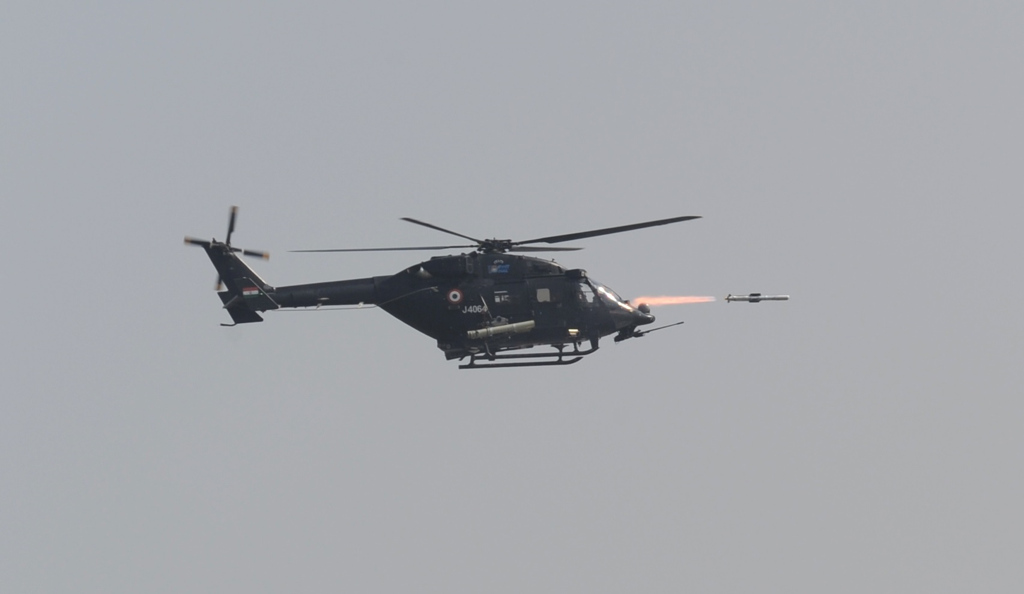In a boost to India’s Aatmanirbhar Bharat campaign, the helicopter launched Nag anti-tank guided missile (HELINA) is ready for induction into the armed forces. The missile recorded 100 per cent strike rate during recent trials at Pokhran ranges in Rajasthan. With tanks being used in the recent standoff in eastern Ladakh, the weapon can play a key role in a two-front war, where heavy armour is bound to be deployed.
The Hindustan Times reported that the solid propelled anti-tank weapon with a range of over seven km was tested for five days. It hit the target all five times at the range and is now ready for induction on HAL Rudra and light combat helicopters. The final test was conducted on Friday morning.
Helina Trial Video pic.twitter.com/06kHn21XNE
— DRDO (@DRDO_India) February 19, 2021
The HELINA missile is a third-generation anti-tank weapon with infra-red seeker, fire-and-forget features. It is comparable with the wire-guided HJ-8 or Hongjian-8 system with the People’s Liberation Army (PLA) and BARQ laser-guided missile developed by Pakistan.
The HELINA system has an all-weather day and night capability and can take out enemy tanks with conventional and explosive reactive armour. The missile can engage targets both in direct hit mode as well as the top attack mode. The IAF version of the missile is called Dhruvastra.
Since last year, after the hard push of the Atmanirbhar Bharat initiative by Prime Minister Narendra Modi, there has been an energetic effort to develop a new ecosystem for defence manufacturing. This has included modernising archaic defence public sector undertakings, energising shipyards to launching locally-made defence items and signing new memoranda of understanding with the private sector to boost indigenisation.
The Defence Research and Development Organisation (DRDO) is at the forefront of developing indigenous systems including the Agni and Prithvi series of strategic missiles, LCA, Tejas, multi-barrel rocket launcher Pinaka, air defence system Akash, and a wide range of radars and electronic warfare systems.
The results of the Atmanibhar Bharat campaign for the next phase of military modernisation have begun to show. At the beginning of this month, Modi handed over the first of the 118 Arjun Mark 1A main battle tanks (MBT) to army chief General MM Naravane. The Arjun has been designed by the DRDO’s Combat Vehicles Research and Development Establishment (CVRDE) and will be produced by the OFB’s Heavy Vehicles Factory Avadi. The first batch of five MBTs will be handed over to the army within 30 months of signing of the contract.
The political push for the Arjun tanks follows the February 3 award of a contract for 83 LCA Tejas aircraft to Hindustan Aeronautics Ltd (HAL). The contract is worth Rs 48,000 crore – the largest placed with any Indian defence firm and was cleared by the Cabinet Committee on Security on January 13 this year.
On the maritime domain, the induction of the third Scorpene submarine, INS Karanj on Tuesday, has bolstered the Navy’s conventional deterrence and beefed-up India’s coastal defences. India has a series of military tests and trials planned for 2021, including that of the Ballistic Missile Defence (BMD) shield, an Air-Independent Propulsion (AIP) system for submarines, and drones, besides a number of missiles, including a BrahMos with an 800-km range. The trials for the indigenous AIP, which will allow conventional submarines to stay under water for a longer duration, is to begin in the first quarter of 2021.
Also on the agenda is the full-fledged trial of the indigenous Rustom-2 Unmanned Aerial Vehicle (UAV). The DRDO expects Rustom-2 surveillance drone to match the specifications of the Israeli Heron unmanned aerial vehicle used by the Indian Air Force and Navy. The push to Rustom-2 program was given after the People’s Liberation Army (PLA) tried to occupy Indian territory in Ladakh on the basis of a 1959 cartographical claim on the Line of Actual Control (LAC).




















